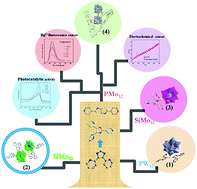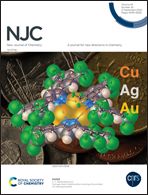Four Keggin-based compounds constructed by a series of pyridine derivatives: synthesis, and electrochemical, photocatalytic and fluorescence sensing properties†
Abstract
By introducing a series of pyridine derivatives as organic moieties, four Keggin-based compounds were synthesized, namely [Ag(Py2Piz)2(H2PW12O40)]·2H2O (1), [Ag4(AcyPh)4(H2SiMo12O40)2]·2H2O (2), [Ag2(Py3Piz)2(H2O)2(H3SiMo12O40)2]·8H2O (3) and {Ag4(Py2TTz)4[Ag(PMo12O40)2]}·Ag(Py2TTz)·2(Py2TTz)·6H2O (4) (Py2Piz = 4,5-bis(2-pyridinyl)imidazole, Py3Piz = 2-(4-pyridyl)4,5-di(2-pyridinyl)imidazole and Py2TTz = 2,5-bis(4-pyridyl)thiazolo[5,4-d]thiazole). In compound 1 the [Ag(Py2Piz)2]+ subunits link Keggin anions through weak Ag-O interactions to form a 1D chain. In compound 2 two mono-supporting Keggin anions are fused by two [Ag(AcyPh)]+ subunits to construct a dimer. In compound 3 there is a mono-capped Keggin anion with an [Ag(Py3Piz)(H2O)]+ subunit. Compound 4 contains a Keggin-dimer linked by an Ag ion. Each dimer is further connected by four sets of [Ag(Py2TTz)]+ lines to construct a 3D framework. All these compounds can be used as nitrite electrochemical sensors. All of them show good photocatalytic activity for MB. In addition, compound 4 shows a selective response to Hg2+ ions.



 Please wait while we load your content...
Please wait while we load your content...